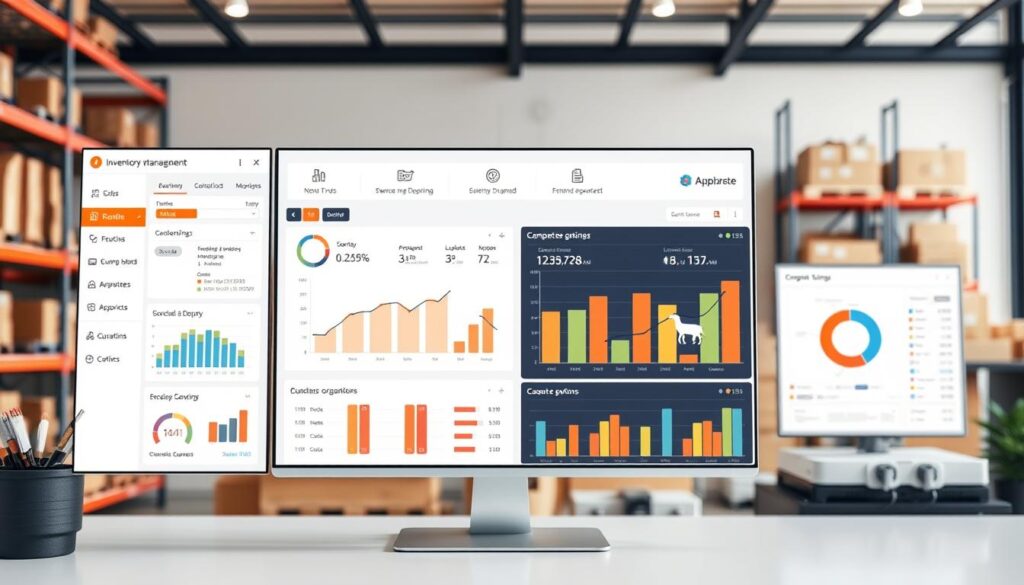Today’s competitive market requires close attention to inventory management. Inventory optimization tools play a key role in this. They help manage stock levels and improve operational efficiencies. Thanks to custom software for inventory management, businesses can align their operations with their unique goals. This personal touch leads to better and precise inventory tracking. Companies enjoy the perks of real-time updates, easy-to-use dashboards, and automatic processes.
Custom software for inventory management is about more than keeping up with the latest tech. It transforms how businesses operate, offering significant cost savings, better customer service, and more accurate inventory counts. This harmony of benefits can positively affect an entire enterprise.
Key Takeaways
- Custom inventory management software tailors solutions to address specific business requirements and workflows.
- Real-time tracking through inventory optimization tools reduces the risk of stockouts and overstock.
- Integration of inventory tracking software with existing systems streamlines operations and minimizes errors.
- Automation within inventory systems not only cuts down on manual labor but also boosts efficiency and accuracy.
- A substantial ROI can be expected from investing in custom software solutions, with full returns realized within months.
- User reviews and ratings can attest to the effectiveness and reliability of custom inventory management platforms.
- Improved decision-making and reduced waste are among the advantages seen by manufacturers implementing tailored inventory software.
Understanding the Importance of Inventory Management Software
As companies grow, handling inventory gets harder. Customized inventory software becomes essential, not just nice to have. Customized inventory software meets businesses’ specific needs. It helps keep operations smooth and customers happy with top-notch inventory control software.
Technology meets inventory management through custom solutions. They greatly improve stock handling and processes. Inventory control software plays a big role in changing the supply chain. It helps avoid problems with stock management, making businesses run better.
Key Benefits of Custom Solutions
Using customized inventory software makes work easier by automating it. This speeds up orders and increases accuracy, reducing expensive mistakes. Companies using this tech save money and work more efficiently. It boosts profits and streamlines operations.
Common Inventory Challenges Faced by Businesses
Inventory control software solves issues like having too much or too little stock, which can lose a lot of money. Over $1.75 trillion is lost globally because of bad inventory management. Optimized inventory systems can save industries from these losses. They also allow real-time tracking, helping businesses stay agile and competitive.
Mistakes like wrong data entry, late buying, and bad stock placing are fixed with the right inventory management software. This tech not just fixes issues but also predicts them. It uses forecasts to prevent having too much or too little in stock.
Investing in customized inventory software aims to create a strong, growing system. It adapts to new challenges and changes in managing stock.
Features to Look for in Custom Inventory Management Software
When looking into custom inventory management software, businesses should focus on features that boost efficiency. It’s essential to choose the right software. This choice helps keep the supply chain smooth and inventory well-managed.
Real-Time Tracking and Analytics
Tracking stock accurately is key in inventory management. Real-time tracking is a must-have feature. It gives instant updates about inventory levels. Information on stock changes, reorder alerts, and order tracking helps keep stock levels right.
Analytics also play a big role in managing inventory through software. They use data to predict demand and guide decision-making. This can help avoid having too much or too little stock. It might even cut inventory costs by up to 25%.
User-Friendly Interface Design
The design of the user interface is very important. A simple-to-use interface makes managing inventory a breeze, even without much training. It should have clear navigation, quick access to common tasks, and easy report making.
Tools like Blaze show the power of an easy interface. They let users manage inventory with no need for coding skills. Features for easy editing and automation make operations smoother. This helps businesses grow without hassle.

Tailoring Inventory Solutions to Suit Your Business Needs
Today’s businesses need custom inventory software more than ever. Every industry and business size faces its own set of challenges. By using inventory systems designed just for them, businesses can boost efficiency and manage inventory better.
Assessing Industry-Specific Requirements
Different sectors have their unique needs for inventory software. A Medical Inventory Management System keeps track of supplies and meets health rules. A Retail Inventory Management System helps stores manage stock and sales better. Each system brings something special to the table, aligned with its industry’s needs.
Customizing Applications for Different Business Sizes
Small businesses often want simple solutions for tracking inventory and orders. Larger companies might look for more advanced features, like analytics and integration. Fleet Inventory Management Software, for example, helps big logistics firms keep track of vehicle parts and maintenance. This ensures smooth operations.
This table shows how different inventory systems help various industries:
| Industry | System Type | Key Features |
|---|---|---|
| Retail | eCommerce Inventory Management | Real-time updates, automated stock alerts, comprehensive reporting |
| Medical | Medical Inventory Management | Real-time tracking, automated alerts, regulatory compliance |
| Hospitality | Hospitality Inventory Management | Stock monitoring for food/beverages, automated replenishment |
| Manufacturing | Manufacturing Inventory Management | Automates raw materials and finished goods management, real-time tracking |
Good inventory software can adapt to any business size or type. By using new tech and methods like Agile, these tailored solutions become even more efficient. They help all kinds of sectors work smoother and manage resources better.
Integration Capabilities with Existing Systems
As companies grow, they need strong inventory management software. It must support key inventory tasks and work well with current ERP and financial software. Custom software for managing inventory is key here. It lets businesses connect with different systems and improve how they operate.
Seamless ERP and Finance Software Connections
Merging inventory management software with ERP systems is a game changer. It can make inventory accuracy jump by 20%. This shows how important it is to have data that syncs across a company’s operations. It helps with analyzing data, financial reporting, and planning. This can make a business run better and cut down on costs.

Take custom software that works with big ERP systems like SAP or Oracle. It can make supply chains run smoother. This means automatic updates between systems, keeping inventory in check with what’s being made and sold.
API Considerations for Multi-Platform Functionality
Today, inventory systems need to work with APIs for different platforms. These APIs let inventory management software talk to other systems. This includes CRM, e-commerce sites, and logistics apps. Good APIs help businesses create a tech ecosystem that adapts to market changes.
APIs keep data consistent across platforms and make things easier for users. For example, when inventory data is shared with CRM platforms through APIs, sales teams know exactly how much stock is available. This helps them set the right expectations for customers.
Choosing inventory management software with good integration features is crucial. The inventory software market is expected to be worth $3.2 billion by 2028. This highlights the growing need for software that connects systems well, supporting business growth.
Cost Considerations for Custom Software Development
Getting custom software for inventory management or bespoke inventory management software might look expensive at first. But it’s important to break down the costs and see how it can save money in the long run for businesses. This will help understand the value and ROI of developing custom software.
Balancing Investment and Future Savings
Yes, creating custom software costs a lot. But when you compare those costs with the future benefits and savings, the picture changes. Solutions bought off the shelf seem cheaper initially, but often need extra custom work. This can lead to higher costs and less than perfect performance later on.
In certain fields like healthcare or FinTech, development costs run between $75,000 and $300,000. This is because of tough rules and the need for tight security. But these costs bring better compliance, data safety, and flexibility, which are big wins from custom solutions.
The ROI of Implementing Inventory Management Solutions
Looking at the ROI of custom software goes beyond just the start-up costs. You have to consider how it lowers expenses in the long run too. Big savings come from better inventory control and cutting down on labor costs. These savings can help balance out the upfront development costs.
| Software Type | Development Cost | Cost Drivers |
|---|---|---|
| Healthcare Inventory Management | $75,000 – $250,000 | Regulatory compliance, Data security |
| Logistics Tracking Software | $50,000 – $250,000 | Real-time tracking, Supply chain management |
| FinTech Applications | $90,000 – $300,000 | Financial integrations, High security |
| Simple Inventory Apps | $10,000 – $50,000 | Basic functionality, Limited scalability |
Also, spending on user experience and connecting systems while developing helps avoid many upgrades later. The costs after you launch, like for support and updates, are key in figuring out how cost-effective the custom option is.
Case Studies: Success Stories of Custom Software Implementation
Custom software has changed how businesses work. For example, Amazon improved its inventory system to handle more sales. This change cut costs and made customers happier. Likewise, Netflix boosted its streaming service globally with its own CDN. This move reduced buffering issues significantly.
Real-World Examples from Various Industries
Uber transformed ride-hailing with its app, using real-time tracking and flexible pricing. This innovation boosted user satisfaction greatly. In manufacturing, Boeing sped up its production while keeping quality high with custom software. Airbnb also benefited from custom software. It improved management for millions of listings, enhancing the user experience and trust in rentals.
Lessons Learned and Best Practices for Future Projects
Custom software leads to big gains for companies. A manufacturing company saw an 80% drop in missing products. A healthcare provider cut admin work by 60%. Also, a financial firm saw a 30% increase in loan approvals with new software. These success stories show the power of custom solutions in improving business.
FAQ
How do inventory optimization tools enhance stock management?
Inventory optimization tools make managing stock easier and more efficient. They use forecasting, real-time tracking, and data analysis. This helps businesses keep just the right amount of stock, cutting costs and avoiding too much or too little inventory.
What are the main advantages of custom software for inventory management?
Custom software is designed to fit a business’s unique needs. It offers detailed tracking of inventory, automates workflows, and updates in real time. It includes dashboards for easy stock supervision and triggers automatic reordering to keep stock levels ideal.
What common challenges do businesses face with inventory management?
Businesses often deal with wasted resources, poor decisions, and the hassle of manual stock checks. Custom software solves these problems. It brings flexibility and accuracy to tracking inventory, reduces waste, and aids in making smart decisions.
Why is real-time tracking crucial in inventory management system development?
Real-time tracking updates stock status instantly. It’s key for keeping stock levels accurate, ordering on time, and satisfying customers. By keeping up with market demands and avoiding losses from old data, it’s essential for success.
How does user-friendly interface design impact inventory management software?
A user-friendly interface makes vital inventory data easily accessible. This allows businesses to monitor transactions and products effortlessly. It improves the user experience and boosts operational performance.
What should businesses consider when customizing inventory software for diverse needs?
Businesses should think about specific needs like mobile barcode scanning or QR scanning. Tailoring the software ensures it fits both small and large companies perfectly. Features should match the unique requirements of the business operations.
How important are integration capabilities in inventory management software?
Integration is crucial for keeping inventory in sync across platforms. It connects with ERP systems, financial software, and apps to streamline workflows. This improves efficiency and functionality significantly.
What are the cost considerations when investing in bespoke inventory management software?
Businesses must compare the initial expense with long-term savings and ROI. Custom software reduces costs by improving bookkeeping, speeding up purchases, and avoiding stock shortages. The financial benefits are significant over time.
What can enterprises learn from case studies of successful custom inventory software implementations?
Case studies show how different sectors benefit from optimizing inventory. They reveal the value of mobile access, automated processes, and strong security. These stories share effective strategies for future projects.
Why should businesses opt for custom inventory management solutions over off-the-shelf software?
Custom solutions are tailored to meet a business’s specific needs. They fit perfectly with a company’s workflow, improving efficiency, accuracy, and the ability to adapt. This beats generic software, offering better results.



